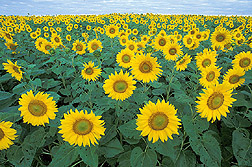This page has been archived and is being provided for reference purposes only. The page is no longer being updated, and therefore, links on the page may be invalid.
|
Read the magazine story to find out more. |
Drought Makes Farmers Mind Their Peas and SunflowersBy Don ComisJuly 19, 2002 A continuing drought in parts of the Northern Plains is causing farmers in dry areas to rethink their crop choices. Some of these farmers put a new CD into their computers this past winter to help plan their spring plantings. The CD contained the new Crop Sequence Calculator, which showed that peas would be the best crop for drought, particularly when rotated with sunflowers. Last year, the earlier version of the calculator went to 2,300 people, mostly farmers. This year’s version has already gone to 3,600. The calculator, developed by scientists at the Agricultural Research Service’s Northern Great Plains Research Laboratory in Mandan, N.D., shows that growing peas one year and sunflowers the next year promises the highest sunflower yield--1,490 pounds an acre. By plugging in a typical price of nine cents a pound, farmers can see predicted gross earnings of $134 an acre. Clicking the “Production Economics” button reveals an estimated average net return of $42.41 for that rotation. That figure came from the 1999 and 2000 experiments in which ARS scientists at Mandan grew all 100 possible combinations of the 10 crops included in the calculator. The pea/sunflower combination is a winner because peas use little water and sunflowers are one of the deepest rooting crops. So when peas are grown first, they leave behind more water in the soil, and the sunflowers can go deeper into the soil to reach that water. The CD contains photo guides to the weeds, insects and plant diseases likely to pose problems. And it has slide shows that display research results and explain the basics of soil, water and pest management. More information on the Crop Sequence Calculator can be found in the July 2002 issue of Agricultural Research magazine. ARS is the U.S. Department of Agriculture's chief scientific research agency. |

